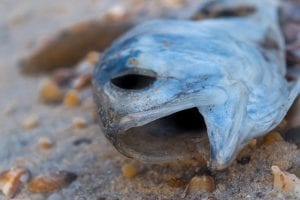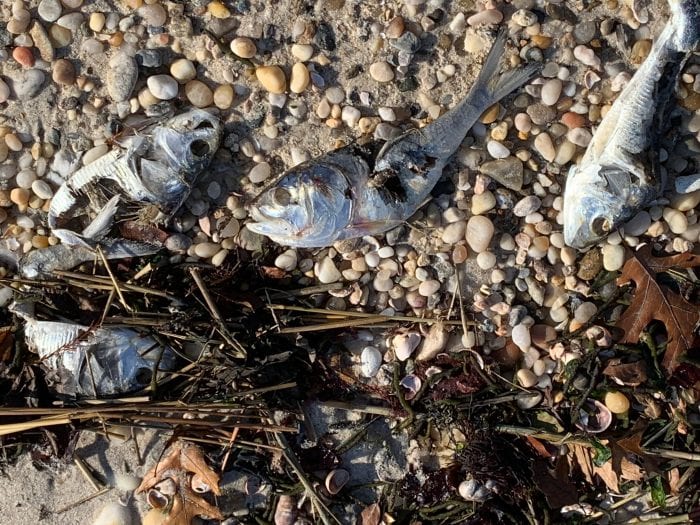Residents Spot Dead Fish on North Shore Beaches
Residents have noticed large numbers of fish found dead on local beaches, though environmentalists said people should not be alarmed.

Co-founder of the Setauket Harbor Task Force, George Hoffman, said a few weeks ago, residents started reporting that as they were walking along West Meadow Beach they noticed a large amount of dead menhaden, a type of forage fish that is also known as a bunker fish. Others have also spotted the menhaden around Setauket and Port Jefferson harbors.
Hoffman said the task force reached out to local scientists, and a few residents contacted the New York State Department of Environmental Conservation as well. The DEC told residents that the die-off events were not unusual. The type of fish swim in large schools and are vulnerable to low dissolved oxygen. The DEC is collecting fish samples for analysis by Stony Brook University’s Marine Animal Disease Laboratory for further evaluation.
It’s the first time the task force has heard of a large die-off locally, Hoffman said. The task force tests the oxygen levels in local harbors regularly during the summer, and he said this year the levels have been good.
He said while the menhaden are not that large, measuring 8 or 9 inches, together they create an unwelcoming sight.
One of the people who noticed the dead menhaden and notified the task force was South Setauket resident Paul Feinberg, who visits West Meadow Beach regularly.
“My initial reaction to this sight back in early December was quite disturbing,” he said.
Bill Lucey, the soundkeeper from Connecticut-based Save the Sound, said the dead menhaden have been spotted along the Connecticut shoreline of the Long Island Sound, too. He has also heard reports of them washing up in the New York City and Hudson River areas.
Lucey said menhaden usually migrate earlier and they may have missed a migration cue due to warmer waters and a larger amount of plankton, which they eat, this year. However, once the temperatures dropped and the plankton died off, they may have faced problems, especially older fish that are less resilient. Normally around this time of year, the bunker fish can be found spawning along the shore of the Carolinas.
Another reason, Lucey said, that residents may be spotting an excess of dead menhaden is that there are more of them in general due to state-imposed fishing regulations. He said a friend of his was on the water fishing earlier this year when he felt a small earthquake in the Sound. His friend saw the menhaden jumping out of the water. Others have mentioned the increased number of bunkers to Lucey, too.
“One sailor said he hadn’t seen that many fish in 57 years,” he said.
Lucey said the increase in the amount of fish is a good thing. Hopefully the harvesting will be sustainable and the population will continue to increase as the bunker fish will attract predators such as humpback whales and bald eagles.
Residents “see a problem, but really it’s potentially a good sign that we have a huge robust population of the forage fish,” he said.
Local environmentalist John Turner agreed. He said with an increase again of menhaden they have been fueling a resurgence of the coastal ecosystem.
“It’s called a forage fish because it feeds and actually filters through the water, so it pulls algae and plankton out of the water, and it converts the microscopic plants that are in the oceans into animal protein,” Turner said. “Then that goes up the food chain again to the whales.”
He added that the menhaden can even be credited with an increase of bald eagles and ospreys in the area.
Lucey said when residents see dead menhaden on the beach to leave the carcasses as the fish will provide food for shoreline birds, which is especially important now that the temperatures are dipping, and there are less fish to be found in the water.







